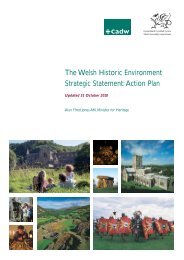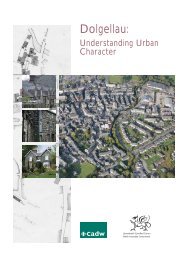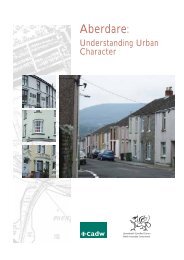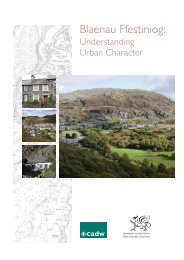Tintern Abbey - Notes for Teachers - Cadw - Welsh Assembly ...
Tintern Abbey - Notes for Teachers - Cadw - Welsh Assembly ...
Tintern Abbey - Notes for Teachers - Cadw - Welsh Assembly ...
Create successful ePaper yourself
Turn your PDF publications into a flip-book with our unique Google optimized e-Paper software.
The window in the west front,<br />
about 1300.<br />
<strong>Tintern</strong> <strong>Abbey</strong><br />
History<br />
<strong>Tintern</strong> <strong>Abbey</strong> was founded in 1131 by the Anglo-Norman lord of<br />
Chepstow,Walter fitz Richard de Clare. He granted land to a small<br />
group of monks from the Cistercian abbey of l’Aumône in France.<br />
The position of <strong>Tintern</strong> <strong>Abbey</strong> is typical of the remote sites chosen<br />
<strong>for</strong> their monasteries by the Cistercians.<br />
At first, the monks probably lived and worshipped in temporary timber<br />
buildings, though by the mid-twelfth century they had erected a stone<br />
church and cloisters.The community grew, and during the first half of<br />
the thirteenth century the abbey buildings were expanded.The superb<br />
Gothic church that still stands, though in ruins, was begun in 1269. It<br />
was consecrated in 1301, almost certainly in the presence of Roger<br />
Bigod, fifth earl of Norfolk, who supported the abbey.<br />
The monks farmed their large estates with the help of lay brothers.<br />
The land was organized into farms known as granges, and they worked<br />
hard to improve the land and increase productivity.<br />
<strong>Tintern</strong> continued to grow through the later Middle Ages despite the<br />
effects of the Black Death, a great plague that struck Britain in 1348,<br />
and the <strong>Welsh</strong> uprising led by Owain Glyn Dwˆ r against the English King<br />
and parliment between 1400 and 1415. Further small-scale building<br />
projects were carried out up until the reign of King Henry VIII.<br />
Then, in September 1536,<strong>Tintern</strong> surrendered to the King during the<br />
suppression of the monasteries, when Henry VIII seized all their land<br />
and wealth.The buildings and land were given to Henry Somerset,<br />
the earl of Worcester. He began to rent out parts of the land to local<br />
people and soon the area around the abbey was crowded with<br />
cottages, workshops and industrial buildings. Iron wire was produced<br />
here and further up the valley.The buildings fell into disrepair, and the<br />
church was used <strong>for</strong> playing quoits.<br />
<strong>Tintern</strong> lay <strong>for</strong>gotten until the late eighteenth century, when it became<br />
fashionable to search out wild landscapes and beautiful ruins. Poets<br />
(including Wordsworth) and artists (including Turner) of the Romantic<br />
movement came in search of the ‘sublime’ and the ‘picturesque’.<br />
Travellers flocked to the area, and were able to reach <strong>Tintern</strong> by boat<br />
from Ross-on-Wye.The railway brought still more tourists after 1876.<br />
In 1901 the site was saved <strong>for</strong> the nation when it was purchased by the<br />
Crown. Major programmes of conservation were first carried out between<br />
1901 and 1928. In 1984 <strong>Tintern</strong> <strong>Abbey</strong> came into the care of <strong>Cadw</strong>, part of<br />
the <strong>Welsh</strong> <strong>Assembly</strong> Government. Researching and maintaining the ruins<br />
and improving facilities <strong>for</strong> visitors are an ongoing process.
1<br />
0<br />
0<br />
West range<br />
2<br />
10<br />
Kitchen<br />
20 Metres<br />
30 60 Feet<br />
Monks’ refectory<br />
Cloister<br />
A i s l e<br />
Nave<br />
A i s l e<br />
3<br />
4<br />
6<br />
Monks’ day room<br />
5<br />
North<br />
transept<br />
South<br />
transept<br />
Looking at the buildings<br />
7<br />
7<br />
7<br />
7<br />
Infirmary<br />
cloister<br />
High<br />
altar<br />
7<br />
7<br />
7<br />
7<br />
Abbot’s<br />
lodgings<br />
Infirmary<br />
The abbey buildings covered a larger area than the present <strong>Cadw</strong> site.<br />
The foundations of other buildings — probably guest accommodation<br />
— and the original entrance can be seen near the car park.<br />
The magnificent church was built at the expense of Roger Bigod, Lord<br />
of Chepstow and was finished about 1330.The position of the smaller<br />
earlier church is marked with lines of stone in the ground.The west<br />
front was highly decorated and in the niche over the door was a<br />
statue of the Virgin Mary, to whom the church was dedicated.<br />
The interior of the church was divided up by stone screens, and<br />
the nave, aisles, monks’ choir and high altar were all separate areas.<br />
In the transepts were chapels, also screened off.The monks<br />
worshipped in the church several times a day, and in the north<br />
transept are the stairs from the monks’ dormitory <strong>for</strong> use at night.<br />
The door in the north aisle is decorated because it is the processional<br />
entrance from the cloister.<br />
In the cloister the monks walked and worked at desks. On the east wall<br />
is a twelfth-century book cupboard (partly blocked by later alterations)<br />
and on the church wall is a seat where the abbot sat <strong>for</strong> the evening<br />
1<br />
2<br />
3<br />
4<br />
5<br />
6<br />
7<br />
Infirmary<br />
kitchens<br />
Porch<br />
Outer parlour<br />
Warming house<br />
Parlour<br />
Chapter house<br />
Book room<br />
Chapel<br />
N
The new-style <strong>Tintern</strong> <strong>Abbey</strong><br />
guidebook contains in<strong>for</strong>mation<br />
about the monks’ lives and<br />
reconstruction drawings. It is<br />
available at 25% discount <strong>for</strong><br />
educational use from <strong>Cadw</strong> Sales.<br />
Tel 01443 336 092/094<br />
Email cadw.sales@wales.gsi.gov.uk<br />
readings of the Bible. Corbels (stone supports) in the cloister walls show<br />
that the covered walkways were rebuilt at least once.<br />
The chapter house was the abbey’s business centre. Note the remains<br />
of seating round the walls and pillars. In the parlour next to it, essential<br />
conversation was allowed.<br />
The monksÕ day room had a stone vaulted roof supported by central<br />
pillars. At right angles was the latrine.This had access from the monks’<br />
dormitory above.The scar of the end wall of the dormitory can be<br />
seen on the end of the north transept.<br />
The monks’ refectory (dining hall) has a decorated doorway and<br />
windows, showing its importance.The doorway in the west wall led to a<br />
pulpit from which a monk read during meals.The kitchen and warming<br />
house lie either side of the refectory, with the prior’s apartments above.<br />
In the central fireplace in the warming house — the only heated room<br />
— a fire was kept from November 1 until Good Friday.<br />
The west range was built as accommodation <strong>for</strong> the lay brothers,<br />
with a dining hall on the ground floor and a dormitory above. Later<br />
this was converted into private apartments. At the south end of this<br />
range is the original entrance through the porch and outer parlour.<br />
The infirmary was originally an open hall, but in the fifteenth century<br />
it was divided to give extra privacy. Next door is the kitchen where<br />
nourishing food <strong>for</strong> the old and sick would be cooked.They were the<br />
only monks allowed to eat meat.<br />
Next to the infirmary is the original abbot’s house. A more palatial<br />
house was built to the north in the fourteenth century as the abbot<br />
rose in status.<br />
Some ideas <strong>for</strong> site activities<br />
Roleplay<br />
• Recreate the monks’ day by moving round the buildings in the<br />
correct sequence.This will help you to understand the monks’<br />
activities and how the buildings were used.<br />
• Use a variety of perspectives — monk, novice, abbot, sick monk,<br />
lay brother, servant — and find the rooms they would have used.<br />
How were their lives different? When would they have met?<br />
• Recreate their procession, chanting simple music.<br />
Looking <strong>for</strong> clues<br />
• Why do some of the pillars in the church have a flattened side?<br />
• Find the remains of decoration. How has the church changed since<br />
it was in use?<br />
• In the chapter house, where did the monks sit?<br />
• What evidence is there that life in the infirmary was more com<strong>for</strong>table?
A40<br />
B4248<br />
Monnow<br />
B4521<br />
B4233<br />
<strong>Cadw</strong><br />
Plas Carew<br />
Unit 5/7 Cefn Coed<br />
Parc Nantgarw<br />
Cardiff CF15 7QQ<br />
Tel 01443 33 6000<br />
Fax 01443 33 6001<br />
Email cadw.education@wales.gsi.gov.uk<br />
Web www.cadw.wales.gov.uk<br />
B4347<br />
Blaenavon Abergavenny Hen Gwrt<br />
Ironworks<br />
Moated Site<br />
Monmouth<br />
Usk<br />
Castle<br />
Raglan<br />
Castle <strong>Tintern</strong><br />
Usk<br />
<strong>Abbey</strong><br />
Newbridge<br />
Pontypool<br />
Chepstow Castle, Port Wall<br />
and Bulwarks Camp<br />
Cwmbran<br />
Runston Chapel<br />
Caerleon Roman Fortress Llanmelin Wood<br />
Hill<strong>for</strong>t<br />
A468<br />
A48 Caerwent<br />
Roman Town<br />
Caerphilly<br />
Castle<br />
NEWPORT<br />
Newport<br />
Castle<br />
A4048<br />
A469<br />
A479<br />
A465<br />
Tretower Castle<br />
and Court<br />
A467<br />
Crickhowell<br />
M4<br />
CARDIFF<br />
A4043<br />
White<br />
Castle<br />
A40<br />
0 Kilometres 8<br />
0 Miles<br />
5<br />
Grosmont<br />
Castle<br />
Skenfrith<br />
Castle<br />
A449<br />
A466<br />
M4<br />
Wye<br />
N<br />
<strong>Tintern</strong><br />
<strong>Abbey</strong><br />
Sketching and measuring<br />
• How can you record the size and height of the church? How much<br />
larger is the present church than the first? Many of the windows have<br />
lost some of their tracery: choose one and draw it as it might have been.<br />
• Is the cloister a square?<br />
• Only about sixty monks lived at <strong>Tintern</strong> at any one time. How many<br />
monks could sit in the chapter house and the dining room?<br />
Leisure and tourism<br />
• Should <strong>Tintern</strong> be left as a ruin or rebuilt?<br />
• How would you improve the presentation of the site <strong>for</strong> visitors?<br />
• Prepare a brief guide <strong>for</strong> a <strong>for</strong>eign visitor.<br />
Your visit<br />
Location<br />
<strong>Tintern</strong> <strong>Abbey</strong> lies beside the A466 between Chepstow and<br />
Monmouth on the west bank of the river Wye, 5 miles (8km)<br />
from junction 2 of the M48.<br />
Facilities<br />
Shop, toilets, parking <strong>for</strong> cars and coaches, audio tour.<br />
Access<br />
A plan of the abbey is given to visitors which includes a recommended<br />
route <strong>for</strong> wheelchair users. A Braille plan with an audio tour is available,<br />
by arrangement with the custodian.The grounds at this site are laid to<br />
grass with some firm, level paths.The entrance to the shop/pay desk is<br />
level.There are in<strong>for</strong>mation panels and an exhibition. Benches are provided.<br />
The abbey car park has five wheelchair symbol spaces. The public toilets<br />
include a disabled toilet though these are not fully adapted.There is also a<br />
radar key toilet in the car park.<br />
Disabled visitors and their assisting companion will be admitted free<br />
of charge to all monuments. Please note that, <strong>for</strong> health reasons,<br />
dogs are not allowed on <strong>Cadw</strong> sites, but guide dogs and hearing<br />
dogs <strong>for</strong> the deaf are welcome.<br />
Further in<strong>for</strong>mation, help and advice on visiting the site is available<br />
from the custodian at the monument, who can also arrange a free<br />
planning visit <strong>for</strong> group leaders.<br />
The Custodian,<strong>Tintern</strong> <strong>Abbey</strong>,<strong>Tintern</strong>, Monmouthshire NP16 6SE<br />
Tel/fax 01291 689251 Email tintern.abbey@cadw.co.uk<br />
Buy the new-style guidebook at 25% discount price <strong>for</strong><br />
educational use from <strong>Tintern</strong> <strong>Abbey</strong> shop or <strong>Cadw</strong> Sales<br />
at the main <strong>Cadw</strong> address.Tel 01443 336 092/094<br />
Email cadw.sales@wales.gsi.gov.uk



![Datganiad Sefyllfa 2008 [pdf, 4190Kb] - Cadw](https://img.yumpu.com/17215647/1/190x135/datganiad-sefyllfa-2008-pdf-4190kb-cadw.jpg?quality=85)

![North Wales Gwynedd [pdf, 485kb] - Cadw](https://img.yumpu.com/17215232/1/184x260/north-wales-gwynedd-pdf-485kb-cadw.jpg?quality=85)
![North Wales Denbigh [pdf, 855kb] - Cadw](https://img.yumpu.com/17215220/1/184x260/north-wales-denbigh-pdf-855kb-cadw.jpg?quality=85)


![Conwy Castle - Notes for Teachers [pdf, 506kb] - Cadw](https://img.yumpu.com/17214402/1/184x260/conwy-castle-notes-for-teachers-pdf-506kb-cadw.jpg?quality=85)




